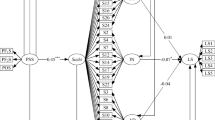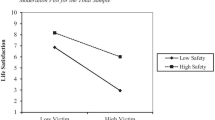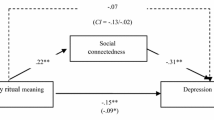Abstract
The present study examined whether life satisfaction mediated social safeness and psychological vulnerability in Turkish youth. The participants included 261 university students who completed a questionnaire package that included the Turkish versions of the Social Safeness and Pleasure Scale, the Satisfaction with Life Scale, and the Psychological Vulnerability Scale. To test the proposed mediation model, authors employed hierarchical regressions. Furthermore, the authors tested mediation model using the Sobel Z-test and bootstrapping method to examine any indirect effects. Consistent with our hypotheses, the results indicated that there was a positive relationship between social safeness and life satisfaction, and a negative relationship between social safeness and psychological vulnerability. The results of the Sobel Z-test and bootstrapping revealed that life satisfaction significantly, yet partially, mediated the relationship between social safeness and psychological vulnerability. The findings highlight the importance of life satisfaction in enhancing perceptions of social safeness and decreasing psychological vulnerability among Turkish college students.

Similar content being viewed by others
References
Aben, I., Denollet, J., Lousberg, R., Verhey, F., Wojciechowski, F., & Honig, A. (2002). Personality and vulnerability to depression in stroke patients: a 1-year prospective follow-up study. Stroke, 33, 2391–2395.
Acun-Kapikiıran, N. (2012). Positive and negative affectivity as mediator and moderator of the relationship between optimism and life satisfaction in Turkish university students. Social Indicators Research, 106(2), 333–345.
Adams, G. A., King, L. A., & King, D. W. (1996). Relationships of job and family involvement, family social support, and work-family conflict with job and life satisfaction. Journal of Applied Psychology, 81(4), 411–420.
Aday, L. (2001). At risk in America. San Francisco: Jossey-Bass.
Akbas, O. (2005). Determination of the high school freshmen level of confidence in the class. Gazi University Journal of Gazi Educational Faculty, 25(2), 275–292.
Akin, A., & Eker, H. (2011). Turkish version of the Psychological Vulnerability Scale: A study of validity and reliability. Paper presented at the 32th International Conference of the Stress and Anxiety Research Society (STAR), July, 18–20, Munster, Germany.
Akin, A., Uysal, R., & Citemel, N. (2013). Sosyal Güvende Hissetme ve Memnuniyet Ölçeğinin Türkçe’ye uyarlanması. Mersin Üniversitesi Eğitim Fakültesi Dergisi, 9(1), 34–40.
Baron, R. M., & Kenny, D. A. (1986). The moderator-mediator variable distinction in social psychological research: conceptual, strategic, and statistical considerations. Journal of Personality and Social Psychology, 51, 1173–1182.
Baruffol, E., Gisle, L., & Corten, P. (1995). Life satisfaction as a mediator between distressing events and neurotic impairment in a general population. Acta Psychiatrica Scandinavica, 92(1), 56–62.
Baumeister, R. F., & Leary, M. R. (1995). The need to belong: desire for interpersonal attachments as a fundamental human motivation. Psychological Bulletin, 117, 497–529.
Bulut Serin, N., Serin, O., & Ozbas, L. F. (2010). Predicting university students’ life satisfaction by their anxiety and depression level. Procedia-Social and Behavioral Sciences, 9, 579–582.
Busseri, M. A., Sadava, S. W., & Decourville, N. (2007). A hybrid model for research on subjective wellbeing: examining common- and component-specific sources of variance in life satisfaction, positive affect, and negative affect. Social Indicators Research, 83, 413–445.
Caine, R. N., & Caine, G. (1991). Making connections. Teaching and the human brain. California: Addison-Wesley Publishing Company.
Cloninger, C. R. (1994). The Temperament and Character Inventory (TCI): a guide to its development and use. Washington University, St Louis, Missouri: Centre for Psychobiology of Personality.
Cox, B. J., Enns, M. W., Walker, J. R., Kjernisted, K., & Pidlubny, S. R. (2001). Psychological vulnerabilities in patients with major depression vs panic disorder. Behavior Research and Therapy, 39, 567–573.
Diener, E. (2000). Subjective well-being: the science of happiness and a proposal of a national index. American Psychologist, 55, 34–43.
Diener, E., & Diener, C. (1995). The wealth of nations revisited: income and quality of life. Social Indicators Research, 36, 275–286.
Diener, E., & Lucas, R. E. (1999). Personality and subjective well-being. In D. Kahneman, E. Diener, & N. Schwarz (Eds.), Well-being: The foundations of a hedonic psychology (pp. 213–229). New York: Russell Sage.
Diener, E., Emmons, R. A., Larsen, R. J., & Griffin, S. (1985). The satisfaction with life scale. Journal of Personality Assessment, 49, 71–75.
Diener, E., Oishi, S., & Lucas, R. E. (2003). Personality, culture, and subjective well-being: emotional and cognitive evaluations of life. Annual Review of Psychology, 54, 403–425.
Diener, E., Wirtz, D., Tov, W., Kim-Prieto, C., Choi, D. W., Oishi, S., & Biswas-Diener, R. (2010). New well-being measures: short scales to assess flourishing and positive and negative feelings. Social Indicator Research, 97, 143–156.
Durak, M., Senol-Durak, E., & Gencoz, T. (2010). Psychometric properties of the satisfaction with life scale among Turkish university students, correctional officers, and elderly adults. Social Indicators Research, 99(3), 413–429.
Edwards, L. M., & Lopez, S. J. (2006). Perceived family support, acculturation, and life satisfaction in Mexican american youth: a mixed-methods exploration. Journal of Counseling Psychology, 53(3), 279–287.
Eng, W., Coles, M. E., Heimberg, R. G., & Safren, S. A. (2004). Domains of life satisfaction in social anxiety disorder: relation to symptoms and response to cognitive-behavioral therapy. Journal of Anxiety Disorders, 19, 143–156.
Gilbert, P. (2005). Compassion: Conceptualisations research and use in psychotherapy. London: Brunner-Routledge.
Gilbert, P. (2009). The compassionate mind. Oakland: New Harbinger Publications Inc.
Gilbert, P. (2010). Compassion focused therapy. New York: Routledge.
Gilbert, P., McEwan, K., Mitra, R., Richter, A., Franks, L., Mills, A., Bellew, R., & Gale, C. (2009). An exploration of different types of positive affect in students and patients with bipolar disorder. Clinical Neuropsychiatry, 6, 135–143.
Gilman, R., & Huebner, E. S. (2006). Characteristics of adolescents who report very high life satisfaction. Journal of Youth and Adolescence, 35(3), 311–319.
Goodwin, R., Cook, O., & Yung, Y. (2001). Loneliness and life satisfaction among three cultural groups. Personal Relationships, 8, 225–230.
Guler, B. K., & Emec, H. (2006). Yaşam memnuniyeti ve akademik başarıda iyimserlik etkisi. Dokuz Eylül Üniversitesi İktisadı ve İdari Bilimler Fakültesi Dergisi, 21(2), 129–149.
Hoshi, M. (2008). Self-transcendence, vulnerability, and well-being in hospitalized Japanese elders. Unpublished PhD thesis, University of Arizona.
Ingram, R. E., & Price, J. M. (2010). Understanding psychopathology: The role of vulnerability. In R. E. Ingram & J. M. Price (Eds.), Vulnerability to Psychopathology: Risk across the lifespan (2nd ed., pp. 3–17). New York: Guilford Press.
Ingram, R. E., & Ritter, J. (2000). Vulnerability to depression: Cognitive reactivity and parental bonding in high-risk individuals. Journal of Abnormal Psychology, 109, 588–596.
Joiner, T. E. (1997). Shyness and low social support as interactive diatheses, with loneliness as mediator: Testing an interpersonal personality view of vulnerability to depressive symptoms. Journal of Abnormal Psychology, 106, 386–394.
Kelly, A. C., Zuroff, D. C., Leybman, M. J., & Gilpert, P. (2012). Social safeness, received social support, and maladjustment: testing a tripartite model of affect regulation. Cognitive Therapy and Research, 36(6), 815–826.
Lucas, R. E., & Gohm, C. (2000). Age and sex differences in subjective well-being across cultures. In E. Diener & E. M. Suh (Eds.), Culture and subjective well-being (pp. 291–317). Cambridge: MIT Press.
Lyubomirsky, S., & Lepper, H. S. (1999). A measure of subjective happiness: preliminary reliability and construct validation. Social Indicators Research, 46, 37–155.
Maslow, A. (1943). A theory of human motivation. Psychological Review, 50, 370–396.
Mechanic, D., & Tanner, J. L. (2007). Vulnerable people, groups, and populations. Health Affairs, 26(5), 1220–1230.
Mesquita, B. (2001). Culture and emotion. Different approaches to the question. In T. J. Mayne & G. A. Bonanno (Eds.), Emotions. Current issues and future directions (pp. 214–250). New York: Guilford Press.
Nes, R. B., Czajkowski, N. O., Roysamb, E., Orstavik, R. E., Tambs, K., & Reichborn-Kjennerud, T. (2012). Major depression and life satisfaction: a population-based twin study. Journal of Affective Disorders, 144, 51–58.
Nes, R. B., Czajkowski, N. O., Røysamb, E., Ørstavik, R. E., Tambs, K., & Reichborn-Kjennerud, T. (2013). Major depression and life satisfaction: a population-based twin study. Journal of Affective Disorders, 144(1), 51–58.
Oh, H. J., Ozkaya, E., & LaRose, R. (2014). How does online social networking enhance life satisfaction? The relationships among online supportive interaction, affect, perceived social support, sense of community, and life satisfaction. Computers in Human Behavior, 30, 69–78.
Paschali, A., & Tsitsas, G. (2010). Stress and life satisfaction among university students: a pilot study. Annals of General Psychiatry, 9, 96.
Pavot, W., & Diener, E. (1993). Review of the satisfaction with life scale. Psychological Assessment, 5, 164–172.
Pinto-Gouveia, J., Ferreira, C., & Duarte, C. (2012). Thinness in the pursuit for social safeness: an integrative model of social rank mentality to explain eating psychopathology. Clinical Psychology and Psychotherapy, 21(2), 154–165.
Preacher, K. J., & Hayes, A. F. (2008). Asymptotic and resampling strategies for assessing and comparing indirect effects in multiple mediator models. Behavior Research Methods, 40, 879–891.
Rothstein, B., & Uslaner, E. M. (2005). All for all: Equality, corruption, and social trust. World Politics, 58(1), 41–72.
Satici, S. A., Kayis, A. R., & Akin, A. (2013a). Predictive role of authenticity on psychological vulnerability in Turkish university students. Psychological Reports, 112(2), 519–528.
Satici, S. A., Uysal, R., & Akin, A. (2013b). Authenticity as a predictor of social safeness in Turkish university students. Ceskoslovenska Psychologie, 57(6), 533–541.
Seligman, M., & Csikszentmihalyi, M. (2000). Positive psychology: an introduction. American Psychologist, 55, 5–14.
Sherman, D. K., Bunyan, D. P., Creswell, J. D., & Jaremka, L. M. (2009). Psychological vulnerability and stress: the effects of self-affirmation on sympathetic nervous system responses to naturalistic stressors. Health Psychology, 28(5), 554–562.
Siahpush, M., Spittal, M., & Singh, G. K. (2008). Happiness and life satisfaction prospectively predict self-rated health, physical health, and the presence of limiting, long-term health conditions. American Journal of Health Promotion, 23, 18–26.
Sinclair, V. G., & Wallston, K. A. (1999). The development and validation of the psychological vulnerability scale. Cognitive Therapy and Research, 23(2), 119–129.
Suldo, S. M., & Huebner, E. S. (2004). Does life satisfaction moderate the effects of stressful life events on psychopathological behaviors during adolescence? School Psychology Quarterly, 19, 93–105.
Suldo, S. M., & Huebner, E. S. (2006). Is extremely high life satisfaction during adolescence advantageous? Social Indicators Research, 78, 179–203.
Thielke, S., Harniss, M., Thompson, H., Patel, S., Demiris, G., & Johnson, K. (2012). Maslow’s hierarchy of human needs and the adoption of health-related technologies for older adult. Ageing International, 37(4), 470–488.
Thoits, P. A. (1982). Life stress, social support, and psychological vulnerability: epidemiological considerations. Journal of Community Psychology, 10, 341–62.
Triandis, H. C. (2001). Individualism‐collectivism and personality. Journal of Personality, 69(6), 907–924.
Van Hoorn, A. (2007). A short introduction to subjective well-being: Its measurement, correlates and policy uses. http://www.oecd.org/site/worldforum06/38331839.pdf.
Wang, C. E. (2006). Depression and cognitive vulnerability. Unpublished PhD thesis, University of Tromso.
Yamawaki, N., Nelson, J. A. P., & Omori, M. (2011). Self-esteem and life satisfaction as mediators between parental bonding and psychological well-being in Japanese young adults. International Journal of Psychology, 3(1), 1–8.
Yavuzer, Y., & Çivilidag, A. (2014). Mediator role of depression on the relationship between mobbing and life satisfaction of health professionals. Düşünen Adam Dergisi, 27(2), 115–125.
Yetim, U. (2003). The impacts of individualism/collectivism, self-esteem, and feeling of mastery on life satisfaction among the Turkish university students and academicians. Social Indicators Research, 61(3), 297–317.
Young, G. A. (1994). Bootstrap: more than a stab in the dark? Statistical Science, 9(3), 382–395.
Author information
Authors and Affiliations
Corresponding author
Rights and permissions
About this article
Cite this article
Satici, S.A., Uysal, R., Yilmaz, M.F. et al. Social Safeness and Psychological Vulnerability in Turkish Youth: The Mediating Role of Life Satisfaction. Curr Psychol 35, 22–28 (2016). https://doi.org/10.1007/s12144-015-9359-1
Published:
Issue Date:
DOI: https://doi.org/10.1007/s12144-015-9359-1




